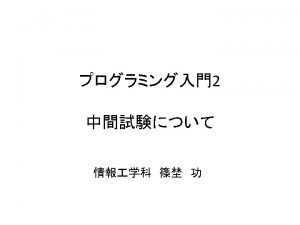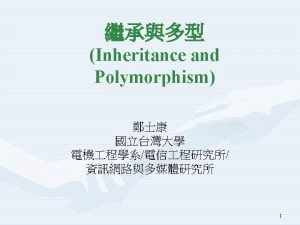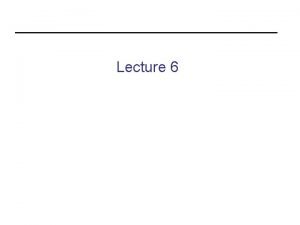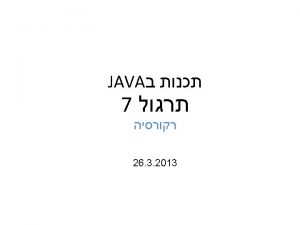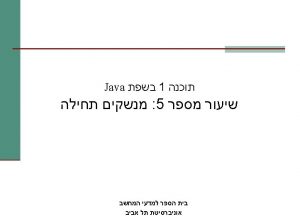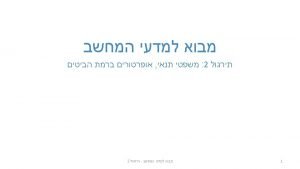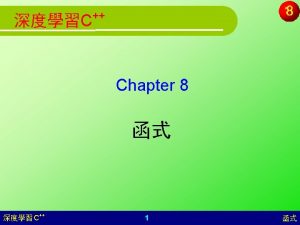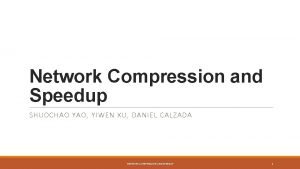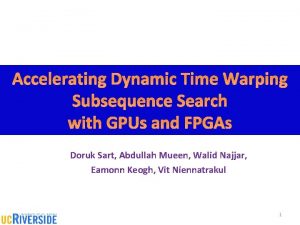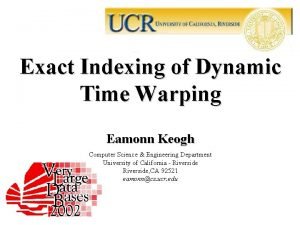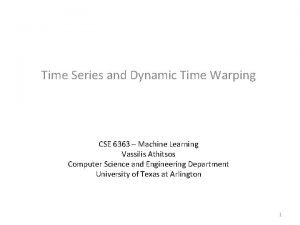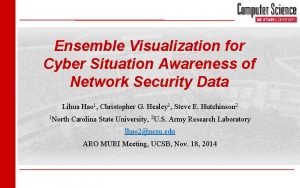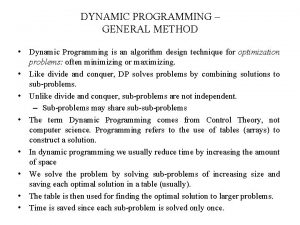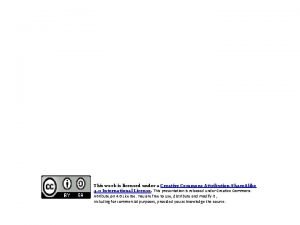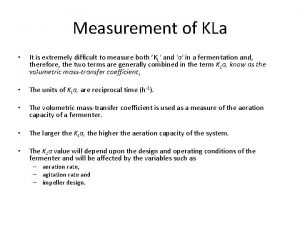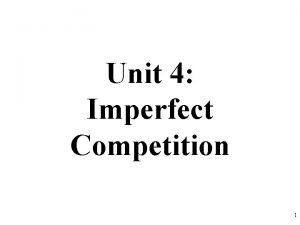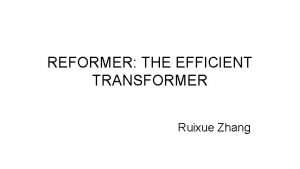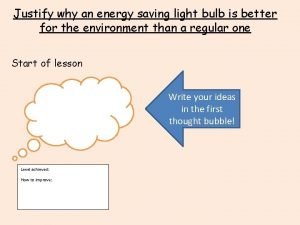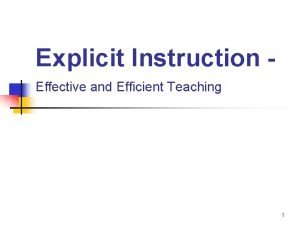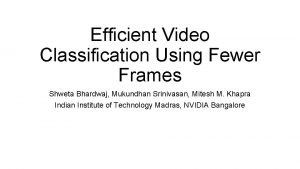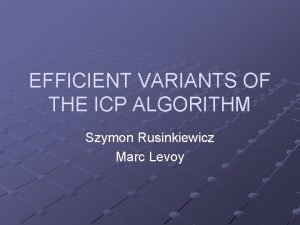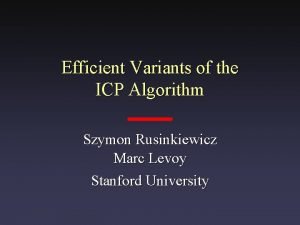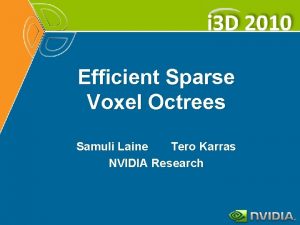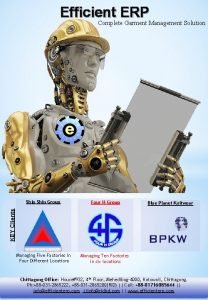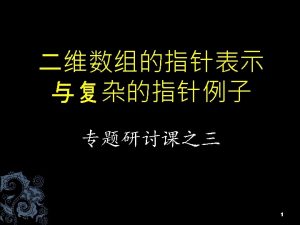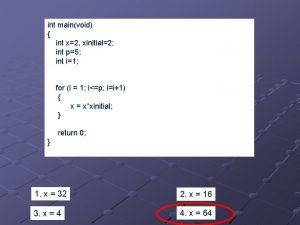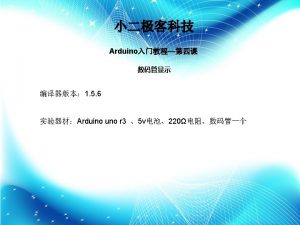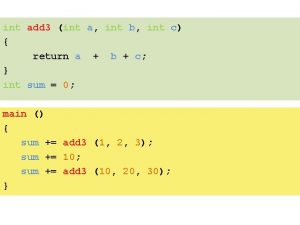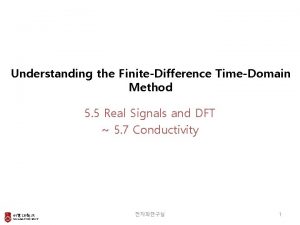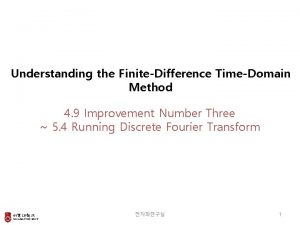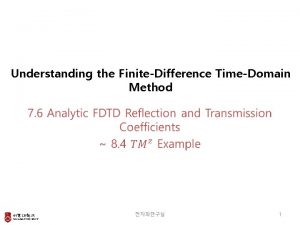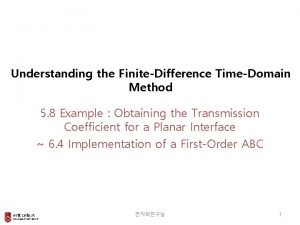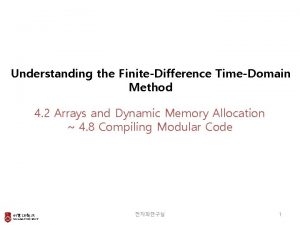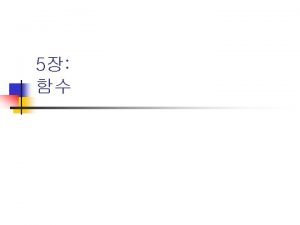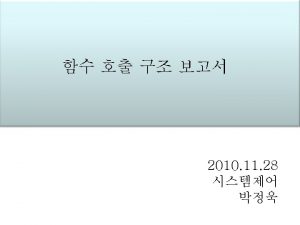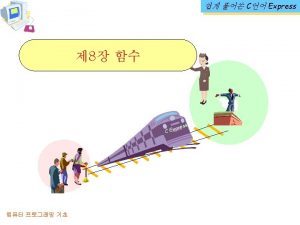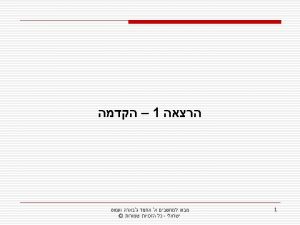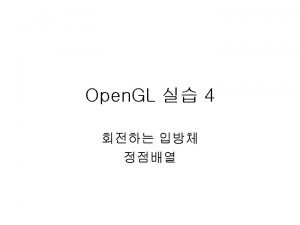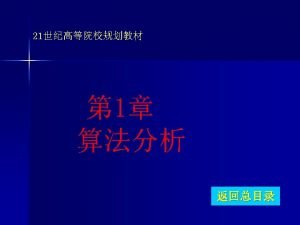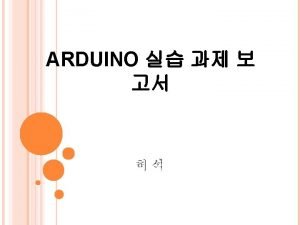Int ro Dynamic AMRFDTD Method Efficient FiniteDifference Time













































- Slides: 45

Int ro Dynamic AMRFDTD: Method Efficient Finite-Difference Time. Domain Modeling of Driven Periodic Structures Dynamic AMR-FDTD: Microwave Circuit Example Dynamic AMR-FDTD: v. Dongying Li and Costas D. Sarris Optical Structure Example Dynamic AMRFDTD: Error analysis/ control Co ncl usi on v The Edward S. Rogers Sr. Department of v Electrical and Computer Engineering v University of Toronto Research supported by the Natural Sciences and Engineering Research Council of Canada (NSERC) and the Ontario Centers of Excellence. 1 IEEE AP-S International Symposium, Honolulu Hawaii, Jun. 14 2007 Ann Arbor, Monday May 22, 2006

Outline Int ro Floquet ’s theore m& PBC Array scanni ng method PBG substra tes exampl e TLmetamateria l exampl e Co ncl usi on v Introduction • Motivation of the research • Previous work v Theory • Floquet's theorem and sine-cosine periodic boundary condition (PBC) • Array scanning method v Numerical Examples • Printed structure on PBG substrates • Transmission-line (TL) metamaterials v Conclusions and future work 2 IEEE AP-S International Symposium, Honolulu Hawaii, Jun. 14 2007

Motivation Int ro Floquet ’s theore m& PBC Array scanni ng method PBG substra tes exampl e TLmetamateria l exampl e Co ncl usi on 3 v Metamaterials • Simultaneous negative • Split-ring resonator (SRR), strip-wire, transmission-line (TL) grid • Design of metamaterials closely related to periodic structure modeling v periodic structures modeling IEEE AP-S International Symposium, Honolulu Hawaii, Jun. 14 2007

Int ro ro Floquet ’s theore m& PBC Array scanni ng method PBG substra tes exampl e Finite-Difference Time-Domain (FDTD) Yee’s cell FDTD: Domain decomposition in “Yee cells”; marching in time Example : FDTD discretization of TLmetamateria l exampl e Co ncl usi on Marching in time scheme 4 IEEE AP-S International Symposium, Honolulu Hawaii, Jun. 14 2007

Mesh Refinement in FDTD Int ro ro Floquet ’s theore m& PBC • Local mesh refinement schemes: Embedding a locally dense mesh into a coarse mesh. Example: Non-uniform mesh for microstrip Array scanni ng method PBG substra tes exampl e TLmetamateria l exampl e Co ncl usi on • Mesh refinement guided by physical intuition; statically defined at the start of the simulation. I. S. Kim and W. J. R. Hoefer, MTT-T, June 1990. • Side-effect: stability. S. S. Zivanovic, K. S. Yee, and K. K. Mei, MTT-T, Mar. 1991. M. W. Chevalier, R. J. Luebbers, and V. P. Cable, AP-T, Mar. 1997. M. Okoniewski, E. Okoniewska, and M. A. Stuchly, AP-T, Mar. 1997. • Sample references: 5 IEEE AP-S International Symposium, Honolulu Hawaii, Jun. 14 2007

Why Dynamic Mesh Refinement Int ro ro Floquet ’s theore m& PBC Array scanni ng method PBG substra tes exampl e TLmetamateria l exampl e Co ncl usi on • Time-domain methods register the evolution of a source pulse and its retro-reflections in a given domain. Wideband source Simulated Structure Absorbing boundary • Edges, high-dielectric regions etc. are not continuously illuminated during an FDTD 6 IEEE AP-S International Symposium, Honolulu Hawaii, Jun. 14 2007

Previous Work Int ro ro Floquet ’s theore m& PBC Array scanni ng method PBG substra tes exampl e TLmetamateria l exampl e Co ncl usi on v Adaptive Mesh Refinement [Berger, Oliger, J. Comput. Physics, 1984]: – Computational fluid dynamic tool for hyperbolic PDEs. – Performs selective mesh refinement by factors of 2. – Allows for the dynamic re-generation of coarse/dense mesh regions. v Moving-Window FDTD (MW-FDTD, Luebbers et al. , Proc. IEEE AP-S, June 2003): – Single moving window of fixed width, velocity tracking a forward wave in a wireless link. 7 IEEE AP-S International Symposium, Honolulu Hawaii, Jun. 14 2007

Int ro Floquet Dynamic ’s AMRtheore FDTD: m& Method PBC Array scanni ng method PBG substra tes exampl e TLmetamateria l exampl e Co ncl usi on 8 Dynamically AMR-FDTD: Overview v. Key features of this work on Dynamically Adaptive Mesh Refinement (AMR)-FDTD – Combination of the FDTD technique with the AMR algorithm. – Implementation of a three-dimensional adaptive, moving mesh. IEEE AP-S International Symposium, Honolulu Hawaii, Jun. 14 2007

AMR-FDTD: Root/Child Meshes Int ro Floquet Dynamic ’s AMRtheore FDTD: m& Method PBC Array scanni ng method PBG substra tes exampl e v. The AMR-FDTD starts by covering the computational domain in a coarse mesh (called root mesh), of Yee cell dimensions TLmetamateria l exampl e Co ncl usi on v. Every NAMR time steps, checks whether mesh refinement is needed at any part of the domain. 9 IEEE AP-S International Symposium, Honolulu Hawaii, Jun. 14 2007

Int ro Floquet Dynamic ’s AMRtheore FDTD: m& Method PBC Array scanni ng method PBG substra tes exampl e AMR-FDTD: Root/Child Meshes (cont-d) v. Clustering together cells that have been “flagged” for refinement, it generates a child mesh that covers them, with cell sizes TLmetamateria l exampl e Co ncl usi on 10 v. Recursively, child meshes can be refined by a factor of. Honolulu two if. Hawaii, flagged IEEE AP-S International Symposium, Jun. 14 at 2007

AMR-FDTD: Root / Child Meshes (cont-d) Int ro Floquet Dynamic ’s AMRtheore FDTD: m& Method PBC v Mesh generation corresponds to a tree structure. A: Level 1 (Root) Mesh B 1, B 2, …, B 5: Level 2 Meshes C 1, C 3: Level 3 Meshes Array scanni ng method PBG substra tes exampl e TLmetamateria l exampl e Co ncl usi on MESH TREE Yee cells Level 1 Level 2 Level 3 11 IEEE AP-S International Symposium, Honolulu Hawaii, Jun. 14 2007

AMR-FDTD: Time Stepping Int ro v Stability condition for the root mesh: Floquet Dynamic Field ’s AMRUpdate theore FDTD: s in m& AMRMethod PBC FDTD Array scanni ng method PBG substra tes exampl e v Courant number s < 1. TLmetamateria l exampl e Co ncl usi on v Keeping the same Courant number in all meshes, the time step of level M mesh is: v Note: Note Minimum cell size affects the time step of the corresponding mesh level only (asynchronous updates). 12 IEEE AP-S International Symposium, Honolulu Hawaii, Jun. 14 2007

Adaptive Mesh Refinement Int ro Floquet Dynamic ’s AMRtheore FDTD: m& Method PBC Array scanni ng method PBG substra tes exampl e v Each NAMR time steps, the mesh tree is regenerated. v Method: Calculate energy in each Yee cell and then gradient throughout the domain. TLmetamateria l exampl e Co ncl usi on 13 IEEE AP-S International Symposium, Honolulu Hawaii, Jun. 14 2007

Int ro Adaptive Mesh Refinement (cont -d) v If both of the following conditions are met : both Floquet Dynamic ’s AMRtheore FDTD: m& Method PBC Array scanni ng method PBG substra tes exampl e : predefined thresholds TLmetamateria l exampl e Co ncl usi on cell (i, j, k) of the root mesh is flagged for refinement Ø First criterion: Captures energy gradient peaks. Ø Second criterion: Prevents numerical noise (at later stages) from triggering spurious refinements. 14 IEEE AP-S International Symposium, Honolulu Hawaii, Jun. 14 2007

Int ro Adaptive Mesh Refinement: Clustering v Mesh Refinement is extended at a distance D around a flagged cell: Floquet Dynamic ’s AMRtheore FDTD: m& Method PBC Array scanni ng method PBG substra tes exampl e TLmetamateria l exampl e Co ncl usi on : “spreading” factor v This accounts for wave propagation within the mesh refinement time window of NAMR time steps. v Flagged cells are clustered in rectangular regions following the algorithm of [Berger and Rigoutsos, IEEE Trans. Systems, Man, Cybernetics, Sept. 1991]. Flagged cells 15 IEEE AP-S International Symposium, Honolulu Hawaii, Jun. 14 2007

Application: Microstrip Low-Pass Filter* Int ro Vertical electric field magnitude Floquet ’s theore m& PBC Array scanni Dynamic ng AMR-FDTD: method Microwave Circuit PBG Example substra tes exampl e TLmetamateria l exampl e Co ncl usi on A=40 mm, B 1=2 mm, B 2=21 mm, W=3 mm, 0. 8 mm substrate of er=2. 2 *From Sheen et al, IEEE MTT-T, July 1990. Time = 0 Number of Child Meshes = 1 Refined volume/total volume = 0. 043 16 IEEE AP-S International Symposium, Honolulu Hawaii, Jun. 14 2007

Application: Microstrip Low-Pass Filter Int ro ro Vertical electric field magnitude Floquet Dynamic ’s AMRtheore FDTD: m& Method PBC Array scanni Dynamic ng AMR-FDTD: method Microwave Circuit PBG Example substra tes exampl e TLmetamateria l exampl e Co ncl usi. AMRDynamic FDTD: on A=40 mm, B 1=2 mm, B 2=21 mm, W=3 mm, 0. 8 mm substrate of er=2. 2 Error analysis/ control Co ncl usi on 17 Time = 100 Dt Number of Child Meshes = 1 Refined volume/total volume = 0. 134 IEEE AP-S International Symposium, Honolulu Hawaii, Jun. 14 2007

Application: Microstrip Low-Pass Filter Int ro Vertical electric field magnitude Floquet ’s theore m& PBC Array scanni Dynamic ng AMR-FDTD: method Microwave Circuit PBG Example substra tes exampl e TLmetamateria l exampl e Co ncl usi on A=40 mm, B 1=2 mm, B 2=21 mm, W=3 mm, 0. 8 mm substrate of er=2. 2 Time = 200 Dt Number of Child Meshes = 1 Refined volume/total volume = 0. 525 18 IEEE AP-S International Symposium, Honolulu Hawaii, Jun. 14 2007

Application: Microstrip Low-Pass Filter Int ro Vertical electric field magnitude Floquet ’s theore m& PBC Array scanni Dynamic ng AMR-FDTD: method Microwave Circuit PBG Example substra tes exampl e TLmetamateria l exampl e Co ncl usi on A=40 mm, B 1=2 mm, B 2=21 mm, W=3 mm, 0. 8 mm substrate of er=2. 2 Time = 500 Dt Number of Child Meshes = 3 Refined volume/total volume = 0. 442 19 IEEE AP-S International Symposium, Honolulu Hawaii, Jun. 14 2007

Application: Microstrip Low-Pass Filter Int ro Vertical electric field magnitude Floquet ’s theore m& PBC Array scanni Dynamic ng AMR-FDTD: method Microwave Circuit PBG Example substra tes exampl e TLmetamateria l exampl e Co ncl usi on A=40 mm, B 1=2 mm, B 2=21 mm, W=3 mm, 0. 8 mm substrate of er=2. 2 Time = 800 Dt Number of Child Meshes = 3 Refined volume/total volume = 0. 28 20 IEEE AP-S International Symposium, Honolulu Hawaii, Jun. 14 2007

Evolution of Child Meshes Int ro Floquet ’s theore m& PBC Array scanni Dynamic ng AMR-FDTD: method Microwave Circuit PBG Example substra tes exampl e TLmetamateria l exampl e Co ncl usi on Coverage=Volume In the long-time regime, of child AMR-FDTD meshes / total is equivalent volume of tothe a root-mesh domain based uniform mesh FDTD (reason for no late-time instability). 21 IEEE AP-S International Symposium, Honolulu Hawaii, Jun. 14 2007

Late-Time Regime Int ro Floquet ’s theore m& PBC Array scanni Dynamic ng AMR-FDTD: method Microwave Circuit PBG Example substra tes exampl e TLmetamateria l exampl e Co ncl usi on No late-time instability observed ! 22 IEEE AP-S International Symposium, Honolulu Hawaii, Jun. 14 2007

Optical applications: Power Splitter Int ro Floquet ’s theore m& PBC Array scanni ng method PBG substra tes exampl e Dynamic AMR-FDTD: TLmeta. Optical materia Structure l Example exampl e Co ncl usi on v Dimensions are given in microns. v Dielectric constants: 24 IEEE AP-S International Symposium, Honolulu Hawaii, Jun. 14 2007

Power Splitter: Time-Domain Results Int ro v AMR-FDTD with four levels Floquet ’s theore m& PBC Array scanni ng method PBG substra tes exampl e Dynamic AMR-FDTD: TLmeta. Optical materia Structure l Example exampl e Co ncl usi on Port 2 Port 3 25 IEEE AP-S International Symposium, Honolulu Hawaii, Jun. 14 2007

Power Splitter: Numerical Results (cont-d) Int ro Floquet ’s theore m& PBC v Error Metric: Array scanni ng method PBG substra tes exampl e Dynamic AMR-FDTD: TLmeta. Optical materia Structure l Example exampl e Co ncl usi on 26 IEEE AP-S International Symposium, Honolulu Hawaii, Jun. 14 2007

Int ro Power Splitter: Wave front Tracking Floquet ’s theore m& PBC Array scanni ng method PBG substra tes exampl e Dynamic AMR-FDTD: TLmeta. Optical materia Structure l Example exampl e Co ncl usi on 27 IEEE AP-S International Symposium, Honolulu Hawaii, Jun. 14 2007

Dielectric Ring Resonator* (4 -level AMR) Int ro Floquet ’s theore m& PBC Array scanni ng method Port 2 PBG substra tes exampl e Dynamic AMR-FDTD: TLmeta. Optical materia Structure l Example exampl e Co ncl usi on *Hagness et al. , IEEE J. Lightwave Tech. , vol. 15, pp. 2154 -2165, Nov. 1997. 28 IEEE AP-S International Symposium, Honolulu Hawaii, Jun. 14 2007

Dielectric Ring Resonator (cont-d) Int ro Floquet ’s theore m& PBC Array scanni ng method PBG substra tes exampl e Dynamic AMR-FDTD: TLmeta. Optical materia Structure l Example exampl e Co ncl usi on 29 IEEE AP-S International Symposium, Honolulu Hawaii, Jun. 14 2007

Dielectric Ring Resonator: Late-time regime Int ro Floquet ’s theore m& PBC Array scanni ng method PBG substra tes exampl e Dynamic AMR-FDTD: TLmeta. Optical materia Structure l Example exampl e Co ncl usi on No late-time instability observed ! 30 IEEE AP-S International Symposium, Honolulu Hawaii, Jun. 14 2007

Determining the AMR Parameters Int ro Floquet ’s theore m& PBC Array scanni ng method PBG substra tes exampl e TLmetamateria l exampl e Co ncl usi AMR Dynamic -FDTD: on • Objective: Produce clear guidelines for the determination of the controlling parameters of the AMRFDTD. • Methodology: 2 -D TE case studies run; error compared to reference simulation (densely gridded FDTD) was measured at probe points distributed throughout the computational domain, over time: Error analysis/ control This procedure is aimed at rendering the error bound estimates independent of the simulated structure. 31 IEEE AP-S International Symposium, Honolulu Hawaii, Jun. 14 2007

Choice of thresholds qe, qg Int ro Floquet ’s theore m& PBC Array scanni ng method Errors from several numerical experiments as a function of the thresholds qe, qg are collected. Error curves are fitted with the function: PBG substra tes exampl e TLmetamateria l exampl e Co ncl usi AMR Dynamic -FDTD: on Error analysis/ control 32 • Error bounds for the cases when qe=0 or qg=0 are derived along with the constants C 1 -C 4. IEEE AP-S International Symposium, Honolulu Hawaii, Jun. 14 2007

Effect of window of mesh refinement NAMR Int ro Floquet ’s theore m& PBC Array scanni ng method PBG substra tes exampl e TLmetamateria l exampl e Co ncl usi AMR Dynamic -FDTD: on Error analysis/ control • Every NAMR time steps, cells that need mesh refinement are “flagged”. • Mesh Refinement is extended at a distance D around a flagged cell to account for wave propagation within the mesh refinement time window : : “spreading” factor • Increasing NAMR reduces errors, but also increases simulation time (because of “spreading factor”). • A value that compromises accuracy and efficiency is NAMR=10. 33 IEEE AP-S International Symposium, Honolulu Hawaii, Jun. 14 2007

Effect of number of mesh refinement levels Floquet ’s theore m& PBC • Keeping the resolution constant, the effect of increasing AMR levels is tested (root mesh gets coarser). • Eventually, as the number of levels increases (beyond typically 4), error and simulation time increases. Array scanni ng method • Example: Corrugated waveguide simulation Int ro PBG substra tes exampl e TLmetamateria l exampl e Co ncl usi AMR Dynamic -FDTD: on Error analysis/ control Dimensions in microns 34 IEEE AP-S International Symposium, Honolulu Hawaii, Jun. 14 2007

Conclusions Int ro Floquet ’s theore m& PBC Array scanni ng method PBG substra tes exampl e TLmetamateria l exampl e Co ncl usi on Co nc lu si on 35 v. The dynamically AMR-FDTD implements multiple, adaptively generated subgrids in two/three-dimensional FDTD and achieves up to two-orders of magnitude computation time savings. v. The mesh generation in AMR-FDTD is a self-adaptive process, based on predefined accuracy parameters (CADoriented feature). IEEE AP-S International Symposium, Honolulu Hawaii, Jun. 14 2007

Conclusions (cont-d) Int ro Floquet ’s theore m& PBC Array scanni ng method PBG substra tes exampl e TLmetamateria l exampl e Co ncl usi on Co nc lu si on 36 v. Guidelines for the choice of the AMR parameters were provided by studying their effect on time-domain error metrics. v. Future Research • Refinement of mesh refinement criteria ! • Closed-domain, evanescent-wave problems • High-order finite-differences, conformal meshing IEEE AP-S International Symposium, Honolulu Hawaii, Jun. 14 2007

References Int ro Floquet ’s theore m& PBC v C. D. Sarris, Adaptive Mesh Refinement for Time-Domain Electromagnetics, Morgan&Claypool. Array scanni ng method PBG substra tes exampl e TLmetamateria l exampl e Co ncl usi on v Y. Liu, C. D. Sarris, ``Fast Time-Domain Simulation of Optical Waveguide Structures with a Multilevel Dynamically Adaptive Mesh Refinement FDTD Approach'', IEEE/OSA J. Lightwave Technology, vol. 24, no. 8, pp. 3235 -3247, Aug. 2006. v Y. Liu, C. D. Sarris, ``Efficient Modeling of Microwave Integrated Circuit Geometries via 37 IEEE AP-S International Symposium, Honolulu Hawaii, Jun. 14 2007

Questions/Remarks? Int ro Floquet ’s theore m& PBC Array scanni ng method PBG substra tes exampl e Thank you ! TLmetamateria l exampl e Co ncl usi on E-mail: cds@waves. toronto. edu 38 IEEE AP-S International Symposium, Honolulu Hawaii, Jun. 14 2007

Field Update Flowchart: General Int ro Floquet Field ’s Update theore s in m& AMRPBC FDTD Array scanni ng method PBG substra tes exampl e TLmetamateria l exampl e Co ncl usi on 39 1 Check the number of time steps; if it is an integer multiple of NAMR, re-generate the mesh tree. 2 Update field grid points of the root mesh 3 Copy fields from the root mesh to the child meshes. Update level M meshes 2 M-1 times. 4 Copy fields of the child meshes back to the root mesh for the time steps of the root mesh (interpolating as needed). 5 If maximum time step has been reached, terminate. Otherwise go back to (1). IEEE AP-S International Symposium, Honolulu Hawaii, Jun. 14 2007

AMR-FDTD: Mesh boundary updates Int ro v Types of boundaries Floquet Field ’s Update theore s in m& AMRPBC FDTD Array scanni ng method PBG substra tes exampl e TLmetamateria l exampl e Co ncl usi on 40 IEEE AP-S International Symposium, Honolulu Hawaii, Jun. 14 2007

AMR-FDTD: Mesh boundary updates Int ro v Types of boundaries Floquet Field ’s Update theore s in m& AMRPBC FDTD Array scanni ng method PBG substra tes exampl e TLmetamateria l exampl e Co ncl usi on Segment ea: “Physical boundary” (PB) of a child mesh to a terminating boundary (ABC, PEC etc. ). 41 IEEE AP-S International Symposium, Honolulu Hawaii, Jun. 14 2007

AMR-FDTD: Mesh boundary updates Int ro v Types of boundaries Floquet Field ’s Update theore s in m& AMRPBC FDTD Array scanni ng method PBG substra tes exampl e TLmetamateria l exampl e Co ncl usi on Segment cd: “Sibling boundary” (SB) between child meshes of the same level (same Yee cell volume). 42 IEEE AP-S International Symposium, Honolulu Hawaii, Jun. 14 2007

AMR-FDTD: Mesh boundary updates Int ro v Types of boundaries Floquet Field ’s Update theore s in m& AMRPBC FDTD Array scanni ng method PBG substra tes exampl e TLmetamateria l exampl e Co ncl usi on Segments ab, bc, ed: “Child-Parent boundaries” (CPB’s) between child and parent meshes. 43 IEEE AP-S International Symposium, Honolulu Hawaii, Jun. 14 2007

Mesh boundary updates: CPBs Int ro Floquet Field ’s Update theore s in m& AMRPBC FDTD Array scanni ng method v Child/Parent grid points: Never collocated in space or time (always interleaved). : Child mesh : Parent mesh PBG substra tes exampl e TLmetamateria l exampl e Co ncl usi on v Transfer of field values from the one mesh to the other involves spatial and temporal interpolations. 44 IEEE AP-S International Symposium, Honolulu Hawaii, Jun. 14 2007

Field Update Flowchart: Child/Parent Connection Int ro Floquet Field ’s Update theore s in m& AMRPBC FDTD Array scanni ng method PBG substra tes exampl e TLmetamateria l exampl e Co ncl usi on 1 2 Update E-field points in the parent mesh at (n+1)Dt. 3 For each child mesh, update H-field points at (n+1/4)Dt. 4 For each child mesh, obtain non-boundary Efield points at (n+1/2)Dt. 5 45 Update H-field points in the parent mesh at (n+1/2)Dt. For each child mesh, obtain boundary E-field points at (n+1/2)Dt, invoking interpolated Hfield values of the parent mesh. IEEE AP-S International Symposium, Honolulu Hawaii, Jun. 14 2007

Field Update Flowchart: Child/Parent Connection (cont-d) Int ro Floquet Field ’s Update theore s in m& AMRPBC FDTD Array scanni ng method PBG substra tes exampl e TLmetamateria l exampl e Co ncl usi on 46 6 7 Repeat 3, 4, 5 to advance each child mesh to time step (n+1)Dt. At regions where child/parent meshes overlap, update parent grid points by interpolating child grid points. v This algorithm is recursively applied for the interconnection of higher-level child/parent meshes (for example to connect level 2 to level 3 and so on). IEEE AP-S International Symposium, Honolulu Hawaii, Jun. 14 2007
 Sum0
Sum0 Int max(int x int y)
Int max(int x int y) Inheritance calculator
Inheritance calculator Public void drawsquare(int x, int y, int len)
Public void drawsquare(int x, int y, int len) Public int divide(int a int b)
Public int divide(int a int b) Productively efficient vs allocatively efficient
Productively efficient vs allocatively efficient Productively efficient vs allocatively efficient
Productively efficient vs allocatively efficient Productively efficient vs allocatively efficient
Productively efficient vs allocatively efficient Productively efficient vs allocatively efficient
Productively efficient vs allocatively efficient Productive inefficiency and allocative inefficiency
Productive inefficiency and allocative inefficiency Interface myinterface int foo(int x)
Interface myinterface int foo(int x) Int main int argc char argv
Int main int argc char argv Nnxn com
Nnxn com Int factorial(int n)
Int factorial(int n) 아두이노 const int
아두이노 const int Int main() int num=4
Int main() int num=4 Void swap(int a int b)
Void swap(int a int b) Int f(int n)
Int f(int n) Int max int min c++
Int max int min c++ Include
Include Dynamic network surgery for efficient dnns
Dynamic network surgery for efficient dnns Transferered
Transferered What is elapsed time
What is elapsed time Objectives of symposium
Objectives of symposium Dynamic time warping
Dynamic time warping Eamonn keogh
Eamonn keogh What does this sign mean
What does this sign mean Dynamic time warping
Dynamic time warping Reliability design in dynamic programming
Reliability design in dynamic programming Dynamic method dispatch in java javatpoint
Dynamic method dispatch in java javatpoint Measurement of kla
Measurement of kla Warehouse goals and objectives
Warehouse goals and objectives Price ceiling on monopoly
Price ceiling on monopoly Evidence supporting efficient market hypothesis
Evidence supporting efficient market hypothesis Reformer: the efficient transformer
Reformer: the efficient transformer It is an arrangement of people in an organization.
It is an arrangement of people in an organization. Sankey diagram energy efficient light bulb
Sankey diagram energy efficient light bulb Explicit instruction effective and efficient teaching
Explicit instruction effective and efficient teaching Efficient video classification using fewer frames
Efficient video classification using fewer frames Efficient variants of the icp algorithm
Efficient variants of the icp algorithm Efficient variants of the icp algorithm
Efficient variants of the icp algorithm Efficient sparse voxel octrees
Efficient sparse voxel octrees Efficient processing of deep neural networks pdf
Efficient processing of deep neural networks pdf Efficient markets theory
Efficient markets theory Efficient market hypothesis
Efficient market hypothesis Efficient erp
Efficient erp
